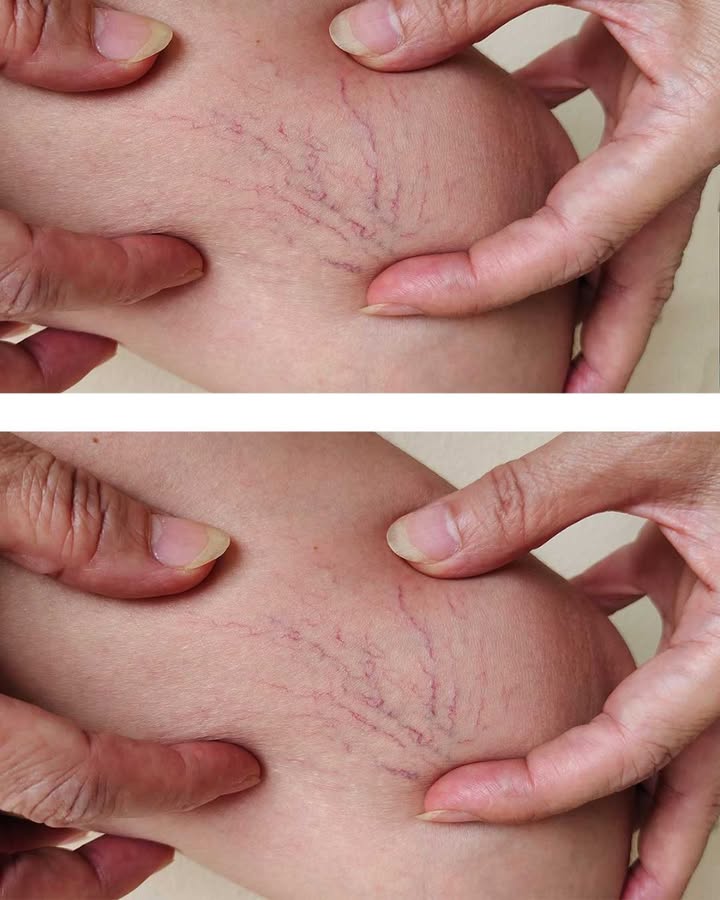ADVERTISEMENT
### **3. Symptoms Associated with Red Veins on the Thighs**
While red veins are often just a cosmetic concern, there are some additional symptoms you should watch for that could indicate a more serious condition. Here are the most common signs to be aware of:
– **Pain or Discomfort:** If the veins on your thighs are causing aching, heaviness, or a dull pain, it could be a sign that you need to address the underlying issue.
– **Swelling:** Swelling around the affected area, especially at the end of the day or after long periods of standing, can suggest a deeper circulatory issue.
– **Itching or Burning:** Some individuals report itching, burning, or skin irritation near the veins.
– **Discoloration:** If the skin around the veins begins to darken or change color, it may indicate that the veins are not functioning properly.
If you notice these symptoms, it’s important to see your healthcare provider sooner rather than later, even if your appointment is a few weeks away.
### **4. When to See a Doctor**
While most cases of visible veins are harmless, it’s important to seek medical advice if you experience any of the following:
– Severe pain or discomfort in the affected area
– Significant swelling or inflammation
– Skin ulcers or sores near the veins
– Blood clots or bruising
– Any sudden changes in the appearance of the veins
Your doctor may conduct tests, such as an ultrasound or a physical exam, to determine the extent of the problem and recommend an appropriate treatment plan.
### **5. Home Remedies and Lifestyle Changes**
While you await your doctor’s appointment, there are several ways to alleviate the discomfort associated with visible veins and improve circulation. Here are some remedies and lifestyle changes you can try:
#### **A. Elevate Your Legs**
Elevating your legs above your heart for 15-20 minutes a few times a day can help relieve swelling and improve circulation. Try lying down and propping your legs up on pillows while you rest or sleep.
#### **B. Exercise Regularly**
Engaging in regular physical activity, especially leg exercises like walking, swimming, and cycling, can improve blood flow and help prevent the development of varicose veins. Exercise strengthens the muscles in your legs, which helps push blood back up toward the heart and reduces the risk of blood pooling.
#### **C. Wear Compression Stockings**
Compression stockings help support the veins in your legs and reduce swelling. These stockings are designed to apply gentle pressure to your legs, helping to improve circulation. They can be purchased over the counter or prescribed by your doctor, depending on your specific needs.
#### **D. Maintain a Healthy Weight**
Maintaining a healthy weight reduces the pressure on your veins and can alleviate the symptoms of visible veins. If you’re overweight, losing even a small amount of weight can make a big difference in reducing strain on your circulatory system.
#### **E. Avoid Prolonged Sitting or Standing**
If your job or daily routine involves sitting or standing for long periods, try to take frequent breaks. Standing up, stretching, and walking around every 30 minutes can help keep the blood flowing properly.
#### **F. Diet and Hydration**
Eating a balanced diet rich in fiber, antioxidants, and anti-inflammatory foods can improve overall vein health. Drink plenty of water to stay hydrated, and avoid excessive salt, which can contribute to swelling.
### **6. Medical Treatment Options**
If your red veins persist or worsen, there are medical treatments available to address the issue. Some common treatment options include:
#### **A. Sclerotherapy**
Sclerotherapy involves injecting a solution into the affected veins that causes them to collapse and fade. This procedure is typically used for spider veins and smaller varicose veins and is performed in a doctor’s office.
#### **B. Laser Treatment**
Laser therapy uses focused light to target and collapse the veins, making them less visible. It’s non-invasive and often used for smaller veins or spider veins.
#### **C. Vein Stripping and Ligation**
For more severe cases of varicose veins, surgery may be required to remove or close off the affected veins. This procedure is typically done under general anesthesia and may require a longer recovery time.
### **7. Conclusion**
The appearance of red veins on your thighs can be concerning, but it’s usually not a cause for panic. Many factors, including genetics, age, pregnancy, and lifestyle, contribute to the development of visible veins. Understanding the possible causes and symptoms of the condition can help you manage it more effectively while you wait for your doctor’s appointment.
In the meantime, lifestyle changes such as elevating your legs, exercising regularly, and wearing compression stockings can provide relief. If the symptoms become more severe or painful, it’s important to seek medical advice sooner rather than later. With the right treatment and proactive care, you can manage visible veins and prevent them from worsening.
Remember, taking care of your circulatory health is essential, and even small changes in your routine can lead to significant improvements in your overall well-being.
